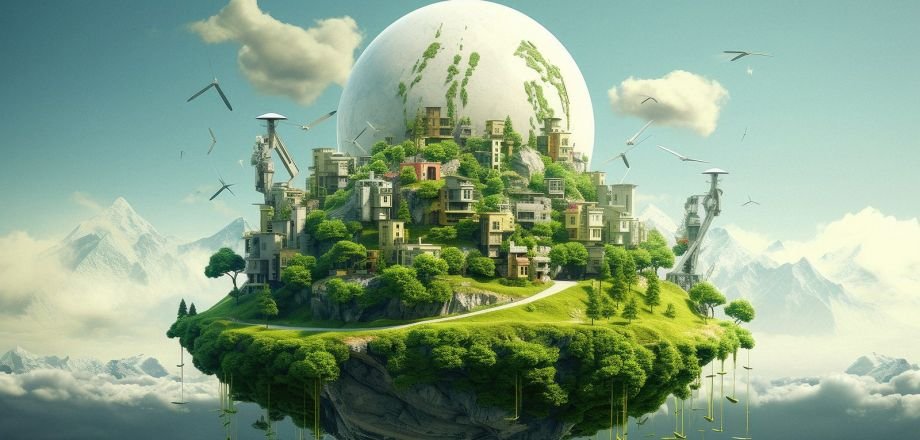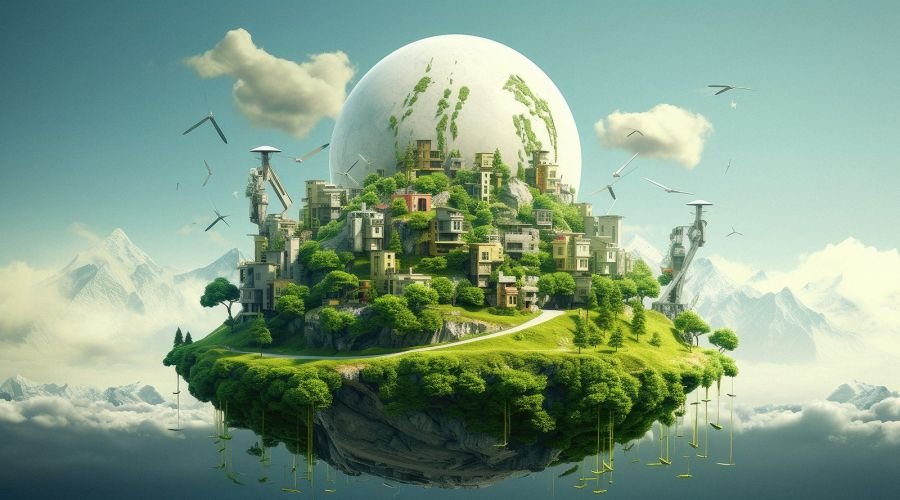The Dawn of Sustainable Websites – A New Era in Digital Design

Saturs
What exactly is a sustainable websites?
In the vast digital landscape, websites are like individual buildings in a sprawling city. Each one, a unique structure, designed and built to serve a specific purpose. But have you ever stopped to consider the environmental footprint of these digital edifices? If you’re like most people, the answer is probably no. After all, they’re not tangible structures made of concrete and steel. They don’t belch out smoke or produce piles of waste. So, how could they possibly be harming our planet?
The world’s first website was launched in 1991, coinciding with the year when Latvia was fully recognized as an independent state by the Soviet Union. I was still in kindergarten then and certainly didn’t even know what a computer was! At that time, sustainability and environmental impact were not as widely discussed or understood as they are today. The concept of a ‘sustainable website’ would have been virtually unheard of in that era.
Imagine walking into a room filled with hundreds of light bulbs, all switched on, all burning energy, all contributing to your electricity bill. Now, imagine that room is your website, and each light bulb is a piece of content, a feature, or a function. The more complex your website, the more light bulbs are burning. This is the energy consumption of your website, and it’s happening 24/7, 365 days a year.
Some 30 years later: today there are 1.13 billion websites in the world. Each of these websites, no matter how small, contributes to the overall energy consumption and carbon footprint of the internet. About 175 new websites are created every minute, 252 000 new websites every day! Each one of them adds to our digital carbon footprint.
Today, the internet is estimated to be responsible for around 3.7% of the world’s carbon dioxide emissions. That’s about the same as the carbon emissions of the entire airline industry combined! The Internet, once considered a non-material, almost weightless realm, now has a tangible, physical impact on our planet.
This is where sustainable websites come into play. A sustainable website is designed and built with the environment in mind. It’s about creating digital spaces that are not only functional and appealing but also energy-efficient and low-impact. It’s about turning off those unnecessary light bulbs, or better yet, replacing them with energy-efficient LEDs.
You might be thinking, “But I’m just a small business owner, or a blogger, or a freelancer. My website is just a drop in the ocean. How much difference can I really make?” The truth is, every bit counts. Just as every vote counts in an election, every website counts in the digital ecosystem. By choosing to make your website sustainable, you’re not only reducing your own digital carbon footprint but also contributing to a larger movement towards a more sustainable internet.
Understanding Sustainable Websites – More Than Just a Buzzword
The Definition of a Sustainable Website
In the simplest terms, a sustainable website is one that is designed and built with an emphasis on energy efficiency and minimal environmental impact. But it’s more than just a buzzword or a trendy concept. It’s a new approach to web design that takes into account not only the user experience and functionality of the website but also its energy consumption and carbon footprint.
The Role of Sustainable Websites in Reducing Carbon Footprint
Just like a well-insulated house uses less energy for heating and cooling, a well-designed website uses less server power and thus produces less carbon emissions. This is achieved through efficient coding, optimized images and videos, streamlined navigation, and content optimization, among other strategies.
But the impact of sustainable websites goes beyond just reducing carbon emissions. They also contribute to a more sustainable digital economy by promoting best practices in web design and development, raising awareness about digital sustainability, and setting a positive example for other businesses and website owners.
The Need for Sustainable Websites – An Imperative in the Digital Age
The Environmental Impact of Traditional Websites
Traditional websites, while serving their purpose in the digital landscape, often overlook the environmental aspect. Each visit to a website, each image loaded, each video played, contributes to the energy consumption of the servers that host these sites. This energy usage, when multiplied by the billions of internet users worldwide, results in a significant carbon footprint.
The Growing Demand for Eco-friendly Digital Solutions
As awareness about climate change and environmental sustainability grows, so does the demand for eco-friendly solutions in all aspects of life, including the digital world. More and more businesses and individuals are recognizing the importance of reducing their digital carbon footprint and are seeking ways to make their websites more sustainable.
Moreover, sustainable websites offer a competitive advantage in the digital marketplace. They load faster, perform better, and offer a superior user experience, all of which can contribute to higher search engine rankings, increased traffic, and improved conversion rates.
Components of a Sustainable Website – Building Blocks of Digital Sustainability
Green Hosting: The Foundation of a Sustainable Website
Just as a house needs a solid foundation, a sustainable website begins with green hosting. Green hosting providers power their servers with renewable energy or purchase carbon offsets to neutralize their environmental impact. Choosing a green hosting provider is the first step towards creating a sustainable website.
Efficient Coding: The Building Blocks of a Sustainable Website
Efficient coding is to a website what quality materials are to a building. The cleaner and more efficient the code, the less server power is needed to run the website. This means faster load times, better performance, and lower energy consumption.
Optimized Images and Videos: Balancing Quality and Sustainability
Images and videos can significantly increase the energy consumption of a website. By optimizing these elements, we can reduce their file size without compromising their quality, leading to faster load times and lower energy usage.
Streamlined Navigation: Enhancing User Experience and Energy Efficiency
A well-designed navigation system not only improves the user experience but also contributes to the sustainability of a website. By making it easy for users to find what they’re looking for, we can reduce the number of server requests and thus the energy consumption of the website.
Content Optimization: Meeting User Needs While Reducing Carbon Emissions
Finally, content optimization is about delivering the right content to the right user at the right time. By eliminating unnecessary content and focusing on what’s truly valuable to the user, we can reduce the energy consumption of the website while improving the user experience.
Design Considerations for Sustainable Websites – Merging Aesthetics with Efficiency
Choosing Energy-Efficient Colors
Did you know that the colors used on a website can affect its energy consumption? Darker colors, especially black, consume less energy than lighter colors. This is particularly true for websites viewed on OLED screens, where each pixel is individually lit. Choosing energy-efficient colors is one way to reduce the energy consumption of your website.
Selecting Sustainable Fonts
Fonts can also impact the sustainability of a website. Some fonts require more processing power to render than others, increasing the energy consumption of the website. By choosing simple, easy-to-render fonts, you can improve the sustainability of your website without compromising its aesthetics.
Adopting a Mobile-First Design Approach
With more than half of all web traffic coming from mobile devices, adopting a mobile-first design approach is crucial for sustainability. Mobile-first design focuses on delivering a seamless user experience on mobile devices, which typically have less processing power than desktop computers. This approach not only improves the user experience but also reduces the energy consumption of the website.
Eco-Grading: Assessing the Sustainability of Your Website
Understanding Eco-Grading
Eco-grading is a method of assessing the environmental impact of your website. It takes into account various factors such as the energy efficiency of your server, the optimization of your images and videos, the efficiency of your code, and the overall user experience. The result is a score that reflects the sustainability of your website.
druvoweb.com Eco-Grading score

Let’s take a look at the eco-grade of our own website, druvoweb.com. According to Ecograder, our website scores a remarkable 95 out of 100. This high score indicates that our website is performing well in terms of sustainability. The report highlights several areas where we excel, such as page weight, UX design, and green hosting.
Breaking Down the Score
Our website’s high score is a result of careful optimization in several key areas:
- Page Weight (96 out of 100): Our website is 121.90% smaller than the average web page, which contributes to faster loading times and lower data usage. This not only improves the user experience but also reduces the carbon footprint of our website.
- UX Design (99 out of 100): Our website is designed to be user-friendly and accessible, helping visitors find what they need quickly and easily. This reduces the amount of time and energy spent on each page, further reducing our website’s environmental impact.
- Green Hosting (100 out of 100): Our website is hosted on servers powered by 100% renewable energy. This significantly reduces the carbon footprint of our website and demonstrates our commitment to sustainability.







Climate Impact
Despite our high score, there is always room for improvement. Our website emits 0,17 grams of carbon dioxide per page load. While this is lower than many websites, it still adds up over time. For example, if our page gets 1,000 pageviews, that’s equivalent to 170 grams of carbon dioxide, comparable to driving an average gasoline-powered passenger vehicle for 0,66 km.
Some more examples
In a year with 10 000 page views per month, druvoweb.com would generate:
- 14,05kg CO₂ – the same as an average sumo wrestler, or enough to boil water for 1903 cups of tea.
- 1 tree – druvoweb.com emits as much carbon as 1 tree absorbs in a year.
- 37kWh of energy – that’s enough electricity to drive an electric car 235 km.
- 56 km – CO₂ emissions are similar to driving from Riga to Sigulda in a car.
- 45 dienas – CO₂ emissions are equivalent to the energy consumption of running an average refrigerator for about 45 days.
Working with a Sustainable Web Designer
The Web Designer’s role in sustainable web design
In the digital age, the role of a web designer extends beyond creating visually appealing websites. It now includes the responsibility of creating sustainable websites that minimize their carbon footprint. This involves designing websites that are efficient, accessible, and respectful of user privacy.
A sustainable web designer understands that every element on a website, from the images and videos to the scripts and fonts, contributes to the site’s energy consumption. They strive to optimize these elements to reduce energy use, thereby decreasing the website’s carbon emissions.
Choosing the Right Web Designer for Your Sustainable Website
Choosing the right developer for your sustainable website involves more than just looking at their portfolio. You need to consider their understanding of sustainable web design principles and their commitment to creating websites that put people and the planet first.
One way to gauge a web designer’s commitment to sustainability is by looking at their own website. Tools like Eco Grader and Website Carbon can give you an idea of how sustainable their website is. These tools provide a sustainability score and suggest actionable tasks to make a website more eco-conscious.
Another factor to consider is the designer’s choice of web hosting provider. A truly sustainable web designer would choose a hosting provider that powers its servers with renewable energy. This can significantly reduce your website’s carbon emissions.
The Future of Sustainable Web Design
As more businesses recognize the importance of sustainability, the demand for sustainable web design is set to increase. This presents a great opportunity for web designers to lead the way in creating websites that are not only visually appealing but also kind to our planet.
In the future, we can expect to see more websites incorporating sustainable design elements, such as low energy modes, energy-efficient designs, and respect for user privacy. We can also expect to see more transparency about the carbon emissions of websites, with more businesses choosing to display their Eco Grader or Website Carbon scores on their websites.
As a web designer, it’s an exciting time to be part of this shift towards a more sustainable internet. By embracing sustainable web design principles, we can help our clients reduce their carbon footprint, improve their brand reputation, and make a positive impact on the planet.
Remember, every bit counts. Even the smallest changes can make a big difference in reducing a website’s carbon emissions. So let’s start making those changes today, and together, we can create a more sustainable internet for everyone.
Encouraging sustainable practices in the digital world can start with education. By raising awareness about the environmental impact of the digital world, we can encourage more people to take steps towards sustainability.
One way to do this is through the creation of sustainable websites. By demonstrating that it’s possible to create a website that’s both attractive and sustainable, we can inspire others to follow suit.s
Finally, we can encourage sustainable practices by leading by example. By implementing sustainable practices in our own digital activities, we can show others that it’s not only possible but also beneficial to be sustainable in the digital world.
druvoWEB

Contemporary web design





